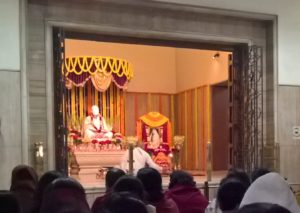On Pilgrimage with my Teacher pt. 1
I am currently on pilgrimage with Babaji Bob Kindler in India and will take a short break from our ongoing study of the first 50 verses of the Vivekachudamani.
We are currently in Delhi, staying right outside the Ramakrishna Mission in Paharganj district. The temple grounds are a peaceful oasis in this otherwise busy, commercial area. Our mornings begin long before sunrise and in time for Mangala Arati, where Sri Ramakrishna is greeted with an offering of fire waved lovingly and majestically – the day begins with Light! The light of Consciousness, ever present, that illumines our mind and our senses, and is projected outwardly as sun, moon, stars, lightning, and fire. Without this Light of Consciousness, the others are incapable of shining! So say the Wise. The monks chant hymns and chapters from the Gita, then all lights except for the Sanctuary are turned off and meditation commences in its radiance – inside and out. In a few hours there will be puja.
This is the third day here. Our first day fell on the birthday celebration for Sri Sarada Devi, the spiritual consort of Sri Ramakrishna. The shrine was especially beautiful on that day with countless strands of marigolds. Devotional music and teachings, feeding of the poor and devotees completed the day. Sri Ramakrishna described her as the embodiment of Kali, Sarasvati, and Durga, who has come to give knowledge and devotion. Like a village cat who rolls in ashes, he said, she is exceedingly difficult to recognize. Behind the veil of modesty, custom, and simplicity, this simple village woman, living the cloistered life of a purdah widow, observing caste rules, was established in samadhi, giving teachings and initiation out of abundant motherly grace to her countless mind-born children – householders and monks alike. She would penetrate to the heart of any issue, set aside socio-cultural strictures instantly as the circumstances required, and bestow spiritual insight with a look, a touch, a thought. Swami Vivekananda’s Irish disciple, Margaret Noble, known as Sister Nivedita, spent many intimate hours with Holy Mother and wrote on two different occasions: “She really is, under the simplest, most unassuming guise, one of the strongest and greatest of women.” And also,”…the stateliness of her courtesy and her great open mind are almost as wonderful as her sainthood. I have never known her to hesitate in giving utterance to large and generous judgement, however new or complex might be the question put before her.”
Traveling with our teacher affords many opportunities for spontaneous and formal teachings. Within our pilgrimage-sangha are those keenly interested in and studying the Advaita, while others are traveling the path of devotion. Given the flexible and comprehensive nature of Sanatana Dharma, and the fresh clarity provided through our lineage, the formless-leaning aspirants embrace God with form along their path, while the devotees of the Divine Form embrace the Formless Reality as the basis of all. It is enriching and purna, purna, purna.
“Extracting the essence from one’s experiences” has been one of many topics Babaji has discussed. It is a multi-faceted teaching. To extract essence from an experience requires one to be in a nonreactive state, to be the witness of experiences. Just as form covers Formlessness, experiences cover the Experiencer. The immature ego jockeys for position to validate and protect itself, and thus the experience is covered with layer after layer of projections, all accepted as real. The Self, the Light of Consciousness that illumines all experiences and is unaffected by them is forgotten, and thus one piles one essentially empty experience on top of others. Satisfaction is not gained nor transcendence and instead, one oscillates between happiness and sorrow endlessly. This teaching pairs well with something Babaji once said to me, “In order to tell it like it is, you have to see it as it is.” That “it” can refer to phenomena as well as the underlying Reality. To see things as they are one has to be the Witness, one’s identity must be posited in the Self, otherwise one is only accepting the immature ego’s interpretation of the world constructed by its own false projections taken to be real. As Swami Vivekananda writes in the “Song of the Sannyasin”: “Let darkness go, will o’ the wisp that leads with blinking light to pile more gloom on gloom. This thirst for life forever quench, it drags from birth to death and death to birth the soul. He conquers all who conquers self (limited). Know this and never yield sannyasin bold. Say – Om Tat Sat, Om!”
More to come. Varanasi is next! Om Tat Sat, Om!



